Finding a wife for the Polish elected prince was a surprisingly difficult task. To do this, it was necessary to endure humiliation, deception and princesses fleeing from the altar. And at the end, overpay for the second-class daughter-in-law anyway. But what is not being done for the son…
Jan III Sobieski tried to ensure a bright future for his firstborn, Jakub. He was looking for a wife who would give him a fortune, title, or influence, preferably all at once. Even though no Polish elected prince had ever married during his father's lifetime , the monarch did not give up.
The Emperor thinks it's a game
The Sobieski family were aiming high from the very beginning. As early as 1681, they proposed a relationship between the 13-year-old Jakub and the one year younger Maria Antonia Habsburg, the firstborn daughter of ... the emperor himself! Marrying the emperor would help the prince gain the Polish throne and inherit ... Spanish! Sobieski did not mind that the virgin was an ugly and dwarf fruit of inbreeding.
In exchange for the girl's hand, Jan proposed to the emperor to abandon the alliance with France and help repel the Turkish storm. However, he was not taken seriously. Habsburg believed that Sobieski had exaggerated the Ottoman threat to force his daughter's hand over. The union was also vetoed by three Eleanors - the Emperor's wife, stepmother and sister, widow of Michał Korybut Wiśniowiecki.
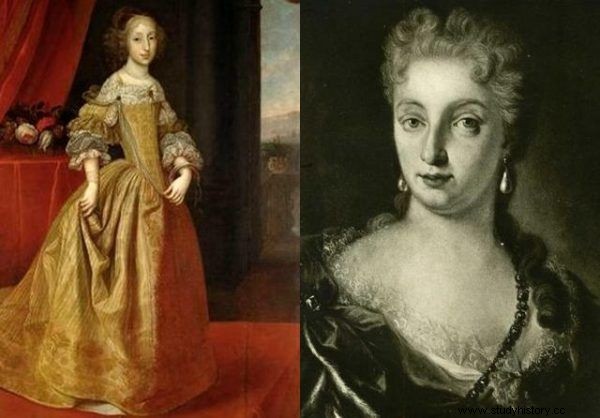
The Sobieski family preferred the hand of the ugly and genetically burdened Maria Antonia (on the left in the painting by Benjamin von Block) to the more beautiful Wiolanta Beatrycze (on the right in the painting by Giovanna Fratellini). Ultimately, none of them became the daughter-in-law of Jan III (source:public domain).
Nevertheless, the Habsburgs tempted the Sobieski family with the hand of Maria Antonia, especially in 1683. Ultimately, the emperor refused Jakub the hand of the archduchess, for the official reason stating that his " daughter cannot stand the Polish climate ". In 1685, the girl married the elector of Bavaria, Maximilian Emmanuel.
This too mediocre…
Meanwhile, near Vienna, Jakub made an attempt to take the matter into his own hands. He made friends with Maximilian Emanuel of Bavaria. The one who later married the Habsburgian woman.
He learned from the elector that he had a beautiful sister. Wiolanta Beatrycze was only 10 years old, but what did it do to dream about marital visions? The Sobieski family decided, however, that the son deserved a better party. Wiolanta married the heir to the Tuscan throne in 1689.
… this one too crowded
In 1684, the youngest son of the Sobieski family was christened. The queen of Portugal was to be godmother. Although the woman died before the ceremony, her husband sent a gift as well as a message to discuss the wedding of his only child, Izabela Ludwika. The girl was sickly, but inherited the Portuguese throne . So it was a very tempting party. Too tempting.
Izabela Ludwika went down in history as "Semper Noiva", meaning "eternally engaged". The king of Portugal promised her hand to various rulers, but nothing came of it.
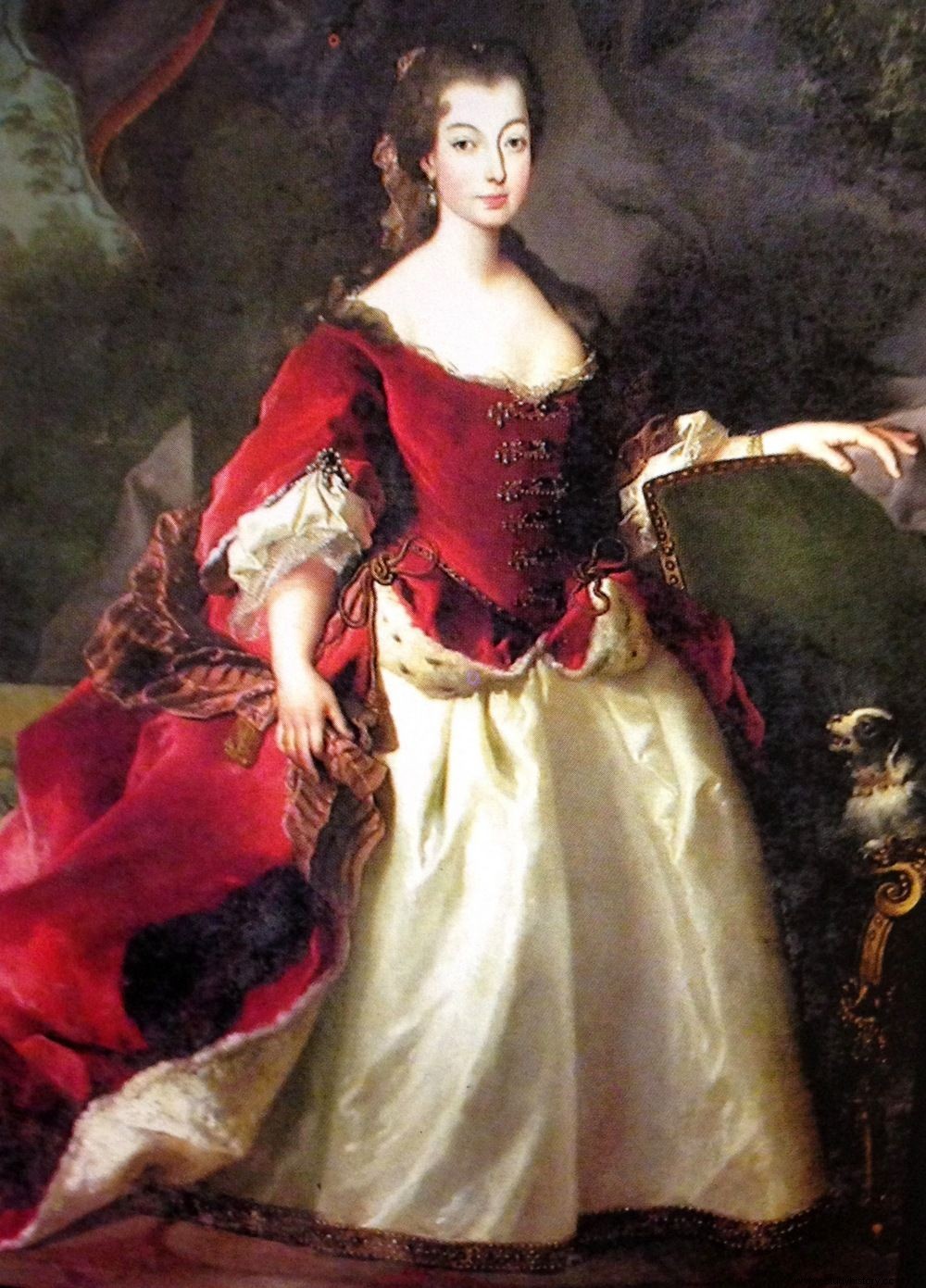
Numerous European princes and monarchs sought the hand of Izabela Ludwika. Among them, the Sobieski family (painting by Dominico Dupra, source:public domain) could not be missing.
Polish treatments lasted two years. The emperor torpedoed it by proposing to the widowed king of Portugal to marry his sister-in-law. The second wife gave the ruler the sons he wanted, and Izabela Ludwika died a virgin.
The Sun King makes fun of
Marysieńka's ambition was to marry her son with a French princess of blood. She thought of the Sun King's niece, Elizabeth Charlotte, Miss Chartres. In 1685, the Sobieski family sent an envoy to Versailles, who had only a vague promise to support Jacob's relationship with the Portuguese Infanta.
Even in the face of imperial diplomacy around the Sobieski family, Louis XIV was not ready to guarantee Jan III the princess of blood. As the French MP said to Marysieńka:
Madame [...] would you like a princess of French blood to be sacrificed, exposing her to the fact that one day she will become, perhaps, just an ordinary old woman from Jawor? , the awning, as it would be said in France.
When the queen heard that Miss Chartres could only marry the king, the Sobieski family expelled French diplomats from the country. Elżbieta Charlotta married the Duke of Lorraine in 1698.
You can always blame the mail
Although the Sobieski family's ambition was the princess's hand, a rich marriage in the Polish-Lithuanian Commonwealth also satisfied them. And the best party among the magnates was Ludwika Karolina, daughter of Bogusław Radziwiłł. As an only child, she inherited a huge fortune. Half of Lithuania belonged to it and her income allowed her to live a royal life.
After the premature death of both her parents, Radziwiłłówna was brought up at the court of the Brandenburg elector. However, she was under the supervision of Jan III Sobieski and could not get married without his consent.
In the spring of 1677, Marysieńka held talks regarding the marriage of her son with Ludwika. Influenced by the opposition of magnates, the elector decided to postpone the talks until the girl was older.
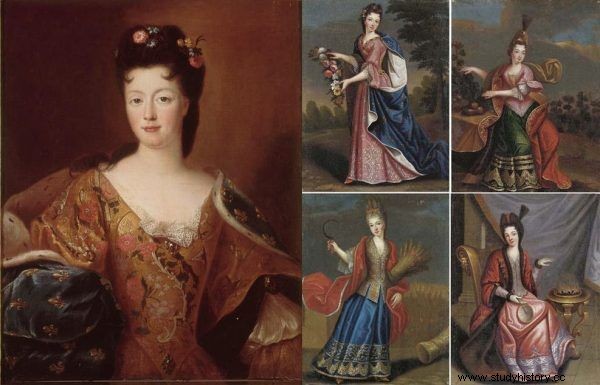
Not only niece Elżbieta Charlotta (on the left) was, according to Louis XIV, too good a party to give her to Sobieski. Also, the four daughters of his distant relative, Henry Julius Condeusz (on the right in Pierre Gobert's illustration), were too well-born for him (source:public domain).
At the turn of 1680 and 1681, the Sobieski family resumed their efforts to win the heiress's hand. But the elector persuaded Radziwiłłówna to marry his son Ludwik. The Hohenzollerns used a trick to this. They sent information to the king about the wedding just before the ceremony so that he would not have time to counteract it. The delay was explained by ... the fault of the mail.
In Poland, the nobility was indignant at the Radziwiłłówna union. Many deputies strove at the Seym for an attack on Ducal Prussia and confiscation of the goods of their magnate daughter. The enemies of the Sobieski family did not allow it. Eventually, the king accepted Ludwika's marriage.
The merry widow
In 1687, Radziwiłłówna's husband suddenly died. In trying to get a young widow, Jakub's friend, the Duke of Courland, Ferdinand Kettler, did not hesitate to deceive her with the vision of a Polish crown on his head, and even ... the conquest of Constantinople! There were also French MPs behind the prince.
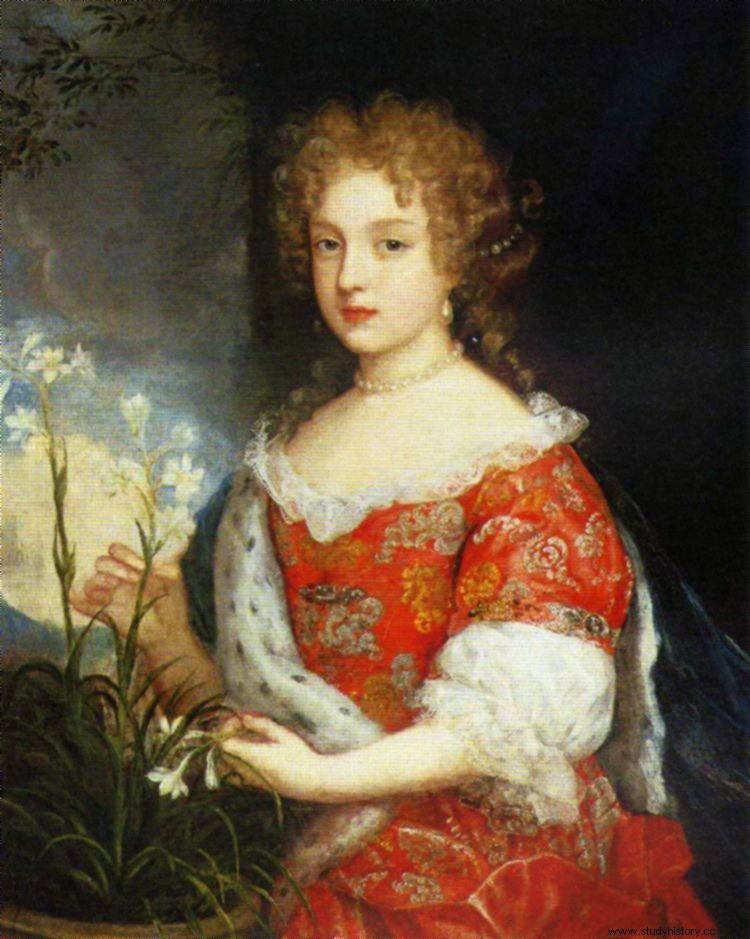
This lovely girl is Ludwika Karolina Radziwiłłówna. The portrait was made around the time she married her first husband, Ludwik Hohenzollern (source:public domain).
Ludwika Karolina was bored at the Puritan Prussian court. Jakub was indifferent to her, but she wanted to break away from her surroundings. She stated that she would marry Jacob if she met him. Although it was not customary of the era, on July 17, 1688, Jacob met Ludwika in Berlin.
Radziwiłłówna received the prince favorably. The young ones exchanged engagement rings. He made her, Calvinist, a promise of religious tolerance. She gave him a written commitment that she would marry him, and if the marriage did not take place, her property would pass to the Sobieski family anyway.
The fiancée promised that she would come to Warsaw in September at the latest. Maria Kazimiera insisted that she come immediately. As it turned out very rightly…
And in the evening she was getting married…
Shortly after Jakub's departure from Berlin, Karol Filip Neuburski, son of a Rhenish palatine and brother of the empress, appeared at the electoral court. As the younger of the elector's sons, his future was not assured. However, there were rumors that the emperor would support him in the future election as king of Poland.
The handsome man met with Radziwiłłówna and won her favor. On the morning of August 10, four days after his arrival, Ludwika Karolina wrote a tender letter to Jakub. Then she went to the imperial embassy. The French envoy tried unsuccessfully to enter the building. He was told that a private meeting was taking place there and ... the keys to the gate were lost. Meanwhile there was a quick wedding and the Radziwiłłówna bedding with Karol Filip in the middle .

The 21-year-old widow made a choice between Prince Jakub Sobieski (on the left, in the painting by Henri Gascar) and Karol Filip Neuburski (on the right, in the painting by Pieter van der Werff). Candidate number two (source:public domain) won.
Upon hearing about this, Jan III was indignant that the girl wrote to Marysieńka, shamed her daughter, and then showed such malice . The queen burst into tears. Grandpa d'Arquien even advised his grandson to challenge his rival to a duel.
Although the Sobieskis had a financial guarantee from Ludwika Karolina, the opposition and the emperor did not let the Radziwiłł lands pass into their hands. It was agreed at the Seym that the management of Ludwika's goods would be taken over by the Sapieha family - the greatest enemies of the Sobieskis in Lithuania . Radziwiłłówna's betrayal severely damaged the authority of the king.
The emperor holds out a piece of his hand
After the Radziwiłł scandal, the emperor noticed that in order to keep Poland in the Holy League, he had to make a concession to the Sobieski family. It was then that the project of matching Jakub with Jadwiga Elżbieta, the younger sister of Empress Eleanor, was born.
The Empress's father was merely an elector of the Palatinate, and not very wealthy . Thanks to Eleanor's marriage, her sisters became great parties. One married the King of Spain, another married the King of Portugal. Although Jadwiga was not the desired candidate, the Sobieski family agreed to the project.
Louis XIV tried to counteract the talks. He claimed that Jadwiga would marry his son and deceived the Sobieski family with the hand of the Hanoverian princess. Marysieńka told the Sun King: If he wants me to break up with the Palatinate princess, he should do for me what the emperor wants to do: give me a princess of his own blood . And there was no such scenario.
Bring the Sobieski family out
Finance dominates premarital negotiations. Marysieńka wanted Jadwiga to receive 200,000 florins of dowry, and the Sobieski family to pay the same amount of dowry. However, her older sisters only received 100,000, and Vienna called for a much higher dowry.
Conversations dragged on mercilessly. Jacob fell at his father's feet, begging to pay the emperor as much as he wanted to get a wife. So John agreed to pay a total of 400,000 florins of a dowry, a wedding gift and a security for widowhood. This amount was four times higher than that contributed by Jadwiga to the marriage.
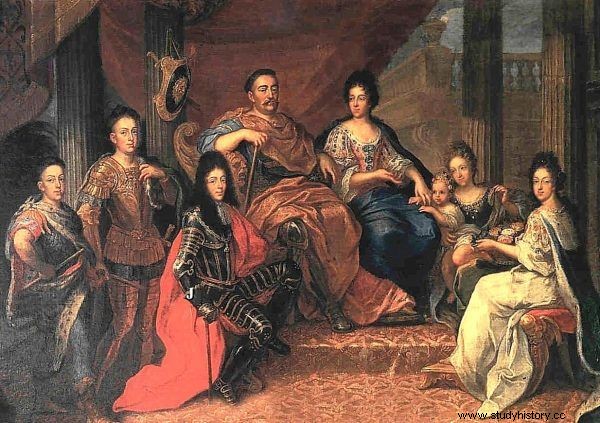
After many hardships, the Sobieski family found their daughter-in-law - not perfect, but loving and devoted. Jadwiga Elżbieta is sitting to the right of Marysieńka, holding her firstborn daughter in her arms, Jakub is sitting next to her father (painting by Henri Gascar, source:public domain).
It was agreed that the basis of the family's maintenance would be 5% of this capital, lent to the emperor, obtained from goods in the Duchy of Oława in Silesia.
The wedding took place on March 25, 1691. He did not live up to all expectations - Jacob did not sit on the throne, and the couple's only son died in infancy . However, the prince found support for his whole life, and their three daughters grew up to be extraordinary women.
***
The ambitions of the Sobieski family seemed to have no limits, and Marysieńka was their driving force. An extraordinary novel by Robert Forys, "Hetman's Gambit" is the story of women who want power above all else. They are ready to pay for it with gold, blood, poison, and even - with their own body.
